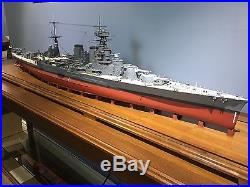
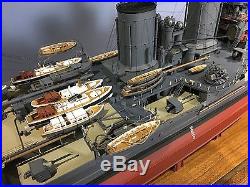

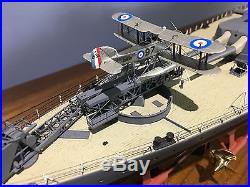
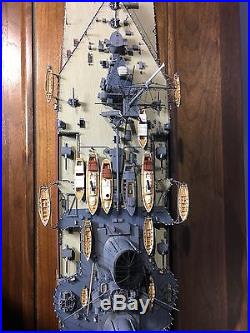
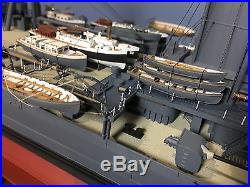

Fine Art Models was founded in 1989 with the singular goal of becoming the finest scale model producer in the world. If you Google Fine Art Models you will see several thousand entries without a single negative comment. Our philosophy is simplescale models are the finest form of art because they are not subjective. They are either right or they are wrong. We view our models as fine art because of their quality and appropriate price. Therefore, we have never had dealers or distributors. We deal directly with our clients and we have only one price. The answer is very simple. After twenty-eight years of business we have had clients pass away and their heirs many times dont realize that we have a secondary market program that we offer all our clients free of charge. We require the model(s) to be in our possession on consignment so that we cannot only represent the condition of the model correctly, but also to insure that the model arrives at its new home in good condition. When this happens, the vast majority of the time we get a call asking us if we can repair the model or if we can provide missing pieces. The answer is usually no because we are not in the repair business for the open market and most likely dont have the missing pieces that are needed. This allows us to focus entirely on our customers and our models. Model Size: 54L x 8W x 12H. Base Type: Black Walnut. Base/Case Size: 62L x 8W x 14H. Flagship of the Royal Navy, internationally recognized symbol of Britains supremacy in sea power, and for twenty years, the most powerful, most beautiful and most prestigious warship in the world was the Battlecruiser HMS Hood. Two years later followed Fishers next brainchild, a longer, faster version of the battleship, but protected no better than a lightly-armored cruiser. These battle-cruisers reflected his theory that in action against lesser enemy warships, their speed would provide all the protection needed. Over the next seven (7) years, Britain built fifteen (15) of these ships; Germany responded with seven (7). At first, Fishers concept appeared vindicated. Twice in 1914, British battle-cruisers engaged and defeated lighter German ships. Thereafter, however, they began to be used in the battle line against similarly armed opponents, whose plunging shells could easily penetrate their thin deck armor. On May 31, 1916, at the Battle of Jutland, three of them exploded with only seventeen of 3,300 crew members surviving. Among those lost with his flagship Invincible was Rear Admiral Sir Horace Hood. She was the first of a class of four (4) ships planned as a reply to rumored German construction. While the other three were later canceled, the Hood, redesigned with somewhat heavier protection in light of the lessons of Jutland, was completed in 1920. For two decades, the mighty Hood was the worlds largest, fastest, and most famous warship. After being assigned to protect British interests during the Spanish Civil War (193639), she served as flagship of the Home Fleet, covering the North Sea and Atlantic from the threat of German surface raiders from her base at Scapa Flow in Scotlands Orkney Islands. By this time, however, new battleships had been built and older ones modernized with improved armor and fire control. Accurate fire could be opened at much longer ranges, from which shells would arrive at increasingly steep angles. With her horizontal protection now clearly inadequate and her speed reduced to 29 knots for want of an overhaul, the Hood was no longer a match for the ships she might have to face in battle. Plans for a three-year modernization were formulated in 1938, but their high cost and the onset of World War II delayed their scheduled implementation until 1942. In May 1941, the latest 30-knot German battleship Bismarck and cruiser Prinz Eugen sortied toward the North Atlantic, intent on destroying merchant convoys. Battle-worthy or not, the Hood and the new, untested battleship Prince of Wales were sent in pursuit. Four ships met in the early morning of May 24, in the Denmark Strait between Iceland and Greenland. Within minutes, the Hood found herself in trouble as the Prinz Eugens second salvo hit her amidships, causing a large fire. Then the Bismarcks fifth salvo hit again and the Hoods after magazines detonated. Under a towering mushroom cloud, her bow rose high into the air as she folded in two and sank, taking with her all but three of her crew of more than 1,400. Her loss staggered Britain much as the Japanese attack on Pearl Harbor shocked America 6 1/2 months later. Each Hood model is built by a team of eight (8) of the most skilled craftsmen in the world with more than 500 man hours just to assemble. Computers were used to generate exact scale drawings from the original plans. In addition, all of the paint used is custom-made and impervious to ultra-violet light. As with all Fine Art Models, the HMS Hood scale model comes complete with a Black Walnut base and leaded glass display case. The item “Fine Art Models 1192 scale HMS HOOD” is in sale since Monday, June 05, 2017. This item is in the category “Collectibles\Transportation\Boats & Ships\Military\Models”. The seller is “corsairfg1d” and is located in Marine City, Michigan. This item can be shipped to United States.
- Country/Region of Manufacture: United States

